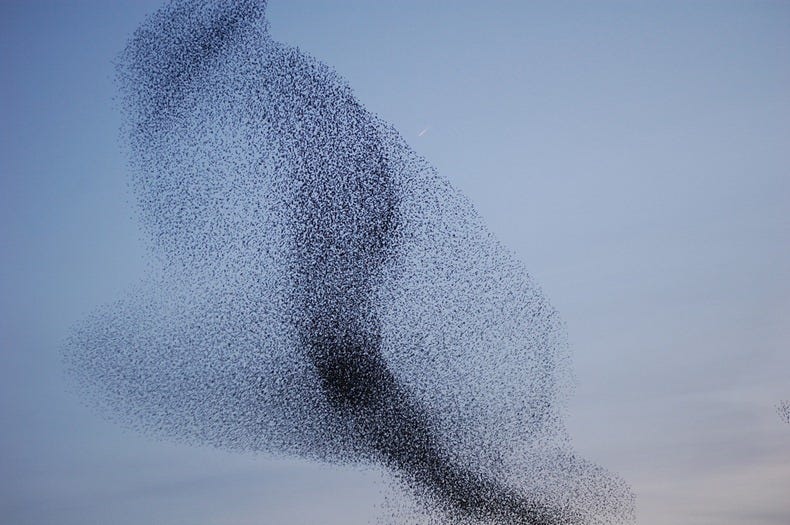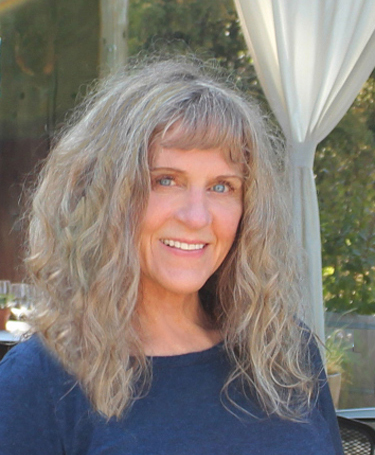This article is dedicated to my fellow super-connectors, movement weavers, story activators, and of course, visionary poets and meta-pattern identifiers — all of whom are seeking to create a more just and equitable world. They include: those who design new economies and value exchanges through open innovation and knowledge sharing; those who strategically connect and relation-build; those with balanced local and planetary perspectives; and those who shape regenerative solutions.

We are like the starlings who fly in free flowing formation — though the micro story patterns continuously change, we sense the emergence of a grand unified story field as we learn to cross boundaries, take creative action and fly together in one movement.
Fight or Flight
Murmuration is a great metaphor for social change. Some of the best lessons for collaboration are found in the dynamics of living systems. Who hasn’t been mesmerized by the graceful beauty of a starling murmuration? The metaphor reveals an intuitive sensing of change, both subtle and strong, in our collective heart and mind. Our inward navigation guides us to move with others who are imagining and implementing whole-systems symmetry.
My personal flight paths are often found on the liminal edge, and many of you have graciously drawn me into your circles of flight. You’ve enticed me by your creative systems imagination and welcoming appreciation. Subtly and fluidly, our flight paths flow together to harmonize in story patterns. Our multiple perspectives converge into unified vision. If one clarifies or changes their intentions, even slightly, big shifts in collective flight patterns can change an entire systems trajectory.
Murmuration reveals a dynamic living systems dance. The starling flocks shape-shift in a swirling aerial ballet while maintaining cohesion as a group. In unison, they conduct evasive maneuvers in uncertain environments often sparked by the presence of a predator species.
This dance is achieved by interacting with six or seven of one’s closest neighbors, optimizing the balance between group cohesion and individual effort. If one bird affects its seven closest neighbors, then each of those neighbors’ movements affect their closest seven neighbors through the flock. This is how a swarm becomes an intelligent cloud traveling in many directions, at various velocities.
Murmurations optimize a form of agility, neural transmissions or signals of shared information which elegantly transcend our rigid organizational diagrams attempting to define self-organization. Like passages of time and music, we resonate at deep levels of universal beauty and symmetry, understanding in ways that transcend explanation.
The science of synchronization
But for those who prefer scientific analysis, Jaymi Heimbuch talks about the science of synchronization at Mother Nature Network, “the secret lies in the same systems that apply to anything on the cusp of a shift, like snow before an avalanche, where the velocity of one bird affects the velocity of the rest.” This is known as “scale-free correlation,” and every shift of the murmuration is called a critical transition. Giorgio Parisi, a theoretical physicist at the University of Rome, lead a research team looking into the amazing movement of starlings and published a paper in the Proceedings of the National Academy of Sciences in 2010:
“The change in the behavioral state of one animal affects and is affected by that of all other animals in the group, no matter how large the group is. Scale-free correlations provide each animal with an effective perception range much larger than the direct inter-individual interaction range, thus enhancing global response to perturbations.”
Jaymi points out,“Because the size of the flock doesn’t matter, a huge flock is able to respond to a predator attack as effectively and fluidly as a small flock. No matter the size, the system works. If one bird changes speed or direction, so do the others. The question remains, however, how does an individual bird spark a change if all are busy responding to the movement of everyone else? And more importantly, how do they do it so incredibly quickly?”
And for systems geeks
Murmurations are a compelling visual representation of “complex adaptive systems.” They self-organize a spontaneous emergence of new patterns, causing adaptive reorganization. The shapes or outcomes cannot be determined since they are not designed from the “outside” (as are most human systems), but are adaptive to the flock itself.
According to systems scientists, because of their ability to process and create information, complex adaptive systems can change their behavior, co-evolve and adjust to new rules that govern relationships with their surrounding environment. These systems are sensitive enough to undergo rapid and unpredictable transformations while they seek to maintain stability and balance in the midst of internal and external fluctuations.
Murmurations also represent systems known as “edge of chaos systems” which are full of creative novelty and experimentation. These systems react to small changes in unexpected ways, communicate instantaneously, and gracefully maneuver unpredictable shifts in direction when responding to predators or roadblocks.
According to John Cleveland’s Complexity Theory — Basic Concepts and Application to Systems Thinking, “A vibrant democracy is an ‘edge of chaos’ form of governance; a healthy market is an ‘edge of chaos’ form of economics; a flexible and adaptive organization is an ‘edge of chaos’ institution; and a mature, well-developed personality is an ‘edge of chaos’ psyche.” He goes on to explain that many systems involve a closed or rigid order which make them incapable of adaptable systems evolution.
Indeed, complex adaptable systems, like nature’s systems, are abstract and thrive in perpetual motion. To some, these systems pose a threat and need to be controlled, harnessed or exploited. History is rife with tension between hierarchical social control (think mechanistic technologies, monopolies, dictatorships) and decentralized, “edge of chaos” systems.
But the great equalizing force between seemingly incoherent chaos and rigid order ideally meets somewhere in the middle on common ground. This is the sweet spot, where new regenerative systems have the opportunity to tap into the creative force of edge chaos (artists thrive in edge chaos systems btw), causing adaptive systems to grow, learn and evolve.

The open knowledge and story platforms set a table — a feast for resource exchange, cooperation, dreaming and making meaning. The collective flight allows for fluid moving between disciplines, sectors, siloed thinking. We become part of a dynamic “murmurating system” that leverages uncertainty while maintaining a form of consensus; a sublime coordination that consistently transitions from scattered chaos to identifiable patterns. And as we seek to learn and make meaningful connections outside of our immediate flocks, the entire pattern shifts.
Synchronization is poetry, poetry is art. Art has always been a more productive use of energy than the “fight”. The cool news is that living systems cannot be controlled by hierarchies or individual parts. Living systems are adaptable whole-systems that seek symmetry, beauty and balance.
As each of us becomes more adept at processing information that is attuned to deeper universal patterns, we can adapt by intuitively navigating complex system realities. We can not only adapt but fly, riding the air currents to higher heights while weaving new story patterns and harmonizing our aligned efforts.
Originally published at Medium.com
Thea La Grou is a visual communicator who occasionally uses words — a “creative entrepreneur,” artist, media alchemist and producer collaborating with cultural creatives, systems architects, and networked movements. She is Co-founder and Marketing Director at Millennia Music & Media, FPC, Founder and Executive Director at Compathos Foundation and is an Edmund Hillary Fellow. Author, speaker, and event producer — Thea specializes in crafting experiences that harness the shifting nuances of storytelling and bring people together to find meaningful action around the common good. Her latest ventures include TwelfthMuse, IMERSIVstorylab, and Films for the Planet— the best in environmental and social action films on demand.
________________________________________
PLEASE DONATE to help Network Weaver continue in it’s mission to offer free support and resources to networks worldwide.
Related Posts
November 4, 2024
Receiving Love and Care: A Liberatory Practice
June 21, 2024




